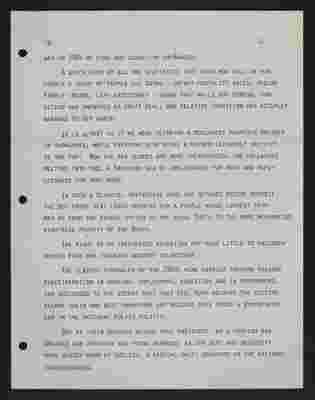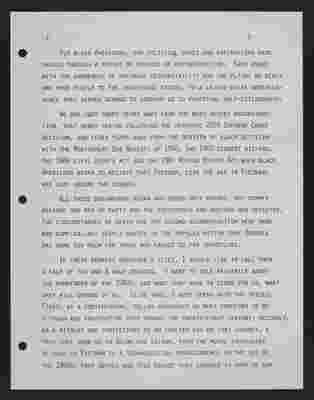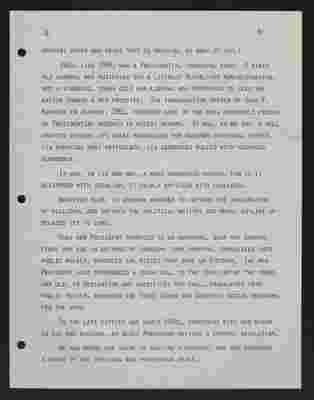Pages
6
[headline] Advance Book Information A Greenwood Press Original Publication
Greenwood Press - 58 Post Road West, P. O. Box 5007, Westport Ct. 06881 Telephone: 203-226-3571 [end headline]
[2 columns] [1st column left hand side] Title Israel in the Black American Perspective.
Author Editor Robert G. Weisbord and Richard Kazarian, Jr.
Series/ISSN Contributions in Afro-American and African Studies, No. 84, ISSN 0069-9624
TP
Lib Bdg $29.95 ISBN 0-313-24016-7
Order Code WIB/
Market/ARC World in English/0001
Publication Date April 1985
Pages Approx. 256 Size 6 1/8 x 9 1/8
Illus. None.
Appendix Bibliography Footnotes Index
First U.S. Edition
Subject Category Black Studies; Ethnic Studies.
LC Number 84-12816
LC Class DS119 Dewey Class 956.94
Author/Editor Biographical Information
Robert G. Weisbord is Professor of History at the University of Rhode Island. He is the author of several books on Jewish and Afro-American historical themes including Genocide?: Birth Control and the Black American (Greenwood Press, 1975), Ebony Kinship: Africa, Africans and the Afro-American (Greenwood Press, 1973) Bittersweet Encounter: The Afro-American and the American Jew, and African Zion: The Attempt to Establish a Jewish Colony in the East Africa Protectorate 1903-1095. In 1983 he was the receipient of Brown's University's Charles H. Nichols Award for reseatch in Afro-American history.
[2nd column right hand side] Description of Book
In their timely book, Israel in the Black American Perpective, authors Robert G. Weisbord and Richard Kazarian, Jr., investigate Black-Jewish estrangement and the erosion of Black support for Isreal. Topics such as the response of Afro-Americans to the early Zionist movement; the emergence of the Jewish state in the Middle East; the attitudes of such Black luminaries as Marcus Garvey, W.E.B. Du Bois, Paul Robeson, and Edward Wilmot Blyden; and Black reactions to the Arab-Israeli conflicts of 1948, 1956, 1967, and 1973 are chronicled and analyzed.
The "normalization" of relations between Israel and the Republic of South Africa in recent years has tarnished Israel's image in Black America and has had a corrosive effect on Black American-Jewish American cooperation. This is examined along with Israel's ties with Black African countries, links between Arab and African nations and South Africa, and alleged Israeli military and nuclear collaboration with the aparthied regime. Another chapter looks at the friction between the Israeli government and a sect of Black "Hebrew Israelities" from the United States who settled in the Negev and at Black American involvement in the matter.
The resignation of Andrew Young as U.S. representative at the United Nations after he held an uunauthorized meeting with the PLO observer is studied in detail, as is the extent to which American Jews and/or Israelis shared in the responsibiity for it. Missons to the Middle East led by Joseph Lowery and Walter Fauntroy of the Southern Christian Leadership Conference and by Jesse Jackson were undertaken in the wake of the Young resignation. These are examined as is a mission to Libya undertaken in September 1979, by a group of Black Americans. The considerable effect that clashes over domestic questions, most notably affirmative action, have had on Black perceptions is also considered. The controversy between Jesse Jackson and the Jewish community is also examined. Based on interviews conducted in the United States, Israel, and Africa and on archival research, this authoritative investigation of Black perspectives of Zionism, Israel, and the Arab-Israeli conflict will be of value to scholars and students of Jewish history, Afro-American history, race relations, and politics.
Richard Kazarian, Jr., is History Department Coordinator and Instructor of American History at the College of Continuing Education at the University of Rhode Island.
For more information, please contact the Promotion Department
7
-5Next, we propose to work. These are the things that we as black men must try to do. To press the matter for stopping the curtailment of our political rights; to urge Negroes to vote intelligently and effectively; to push the matter of civil rights; to organize business cooperation; to build schoolhouses and increase the interest in education; to bring Negroes and labor unions into mutual understanding; to study Negro history; to attack crime among us . . . . to do all in our power by word and by deed to increase the efficiency of our race, the enjoyment of its manhood rights, and the performance of its just duties. This is a large program. It cannot be realized in a short time, but now is the critical time."*
DuBois correctly predicted that the classic problem of the twentieth century would be the problem of the color line.
In the eighty-five years of the twentieth century, the struggle of black Americans has seen several climaxes. These have been years of great legal strugges in the courts, complimented by extra-legal struggles in the streets.
We son [sic] gains at lunch counters and movie theatres and polling places, and the fabric of legal apartheid in the United States began to be destroyed. What had begun as a movement for elemental civil rights has now become a political and economic movement, and black men and women have won office and power in numbers we only dreamed of before.
But despite an impressive increase in the number of black people holding office, despite the ability we now have to sit and eat or ride or vote in places that uaed [sic] to bar black faces, in a very real
8
-6way in 1985 we find our condition unchanged.
A quick look at all the statistics that show how well or how poorly a group of people are doing — infant mortality rates, median family income, life expectancy — shows that while our general condition has improved as [sic] great deal, our relative condition has actually managed to get worse.
It is almost as if we were climbing a mollasses [sic] mountain dressed in snowshoes, while everyone else rifes [sic] a rather leisurely ski-lift to the top. Now the ski slopes are more treacherous, the molasses melting into mud, a Sargasso Sea of joblessnes for many and hopelessness for many more.
In such a climate, yesterdays aims and methods become suspect. The bus front seat loses meaning for a people whose longest trip may be from the feudal system of the rural South to the more mechanized high-rise poverty of the North.
The right to an integrated education may mean little to children bussed from one ignorant academy to another.
The classic struggles of the 1960s were carried forward against discrimination in housing, employment, education and in government, and succeeded to the extent that they did, both because the victims became their own best champions and because they found a sympathetic ear in the national policy politic.
But as their demands became more insistent, as a foreign war drained our treasury and young manhood, as our best and brightest were beaten down by bullets, a radical shift occurred in the national consciousness.
9
-7For black Americans, our politiccal hopes and aspirations have passed through a series of periods of reconstruction. Each ended with the surrender of national responsibility for the plight of black and poor people to the individual states, to a laisse-faire benevelovence that seemed doomed to condemn us to perpetual half-citizenship.
We are just short years away from the most recent reconstruction, that heady period following the historic 1954 Supreme Court decision, and fewer years away from the rebirth of black activism with the Montgomery Bus Boycott of 1956, the 1960 student sit-ins, the 1964 civil rights act and the 1965 Voting Rights Act when black Americans began to believe that Freedom, like the war in Vietnam, was just around the corner.
All these beginnings began and ended once before, not simply because one man or party won the presidency and another was defeated. The circumstances of death for the second reconstruction were many and complex, but deeply rooted in the popular notion that America has done too much for those who cannot do for themselves.
If these remarks required a title, I should like to call them a tale of two and a half decades. I want to talk primarlily about the remainder of 1980s, and what they have in store for us, what they will demand of us. To do that, I must speak with two voices: First, as a contemporary, fellow passenger on what promises to be a tough and frustrating trip toward the twenty-first century; secondly, as a witness and participant to an earlier leg on that journey, a trip that took us to Selma and Saigon, from the moral equivalent of hell in Vietnam to a technological transcendence on the sea of the 1960s, that Jekyll and Hyde decade that spawned so many of our
10
-8present hopes and fears (not to mention, so many of you.)
1961, like 1985, was a Presidential inaugural year. A tired old general was mustering out a listness Republican Administration, and a vigorous, young cold war liberal was preparing to lead the nation toward a new frontier. The inauguration speech of John F. Kennedy in January, 1961, featured some of the more memorable pieces of Presidential rhetoric in recent memory. It was, as we say, a well crafted speech; its ideas marshalled for maximum emotional effect, its phrasing most articulate, its candences rolled with measured eloquence.
It was, in its own way, a most dangerous speech, for if it glistened with idealisn, it fairly bristled with challenge.
Whatever else, it somehow managed to capture the imagination of millions, and defined the political motives and moral outline of decades yet to come.
That new President promised to go anywhere, bear any burden, fight any foe in defense of freedom; that promise, translated into public policy, produced the midset that gave us Vietnam. The new President also pronounced a clear call to the idealism of the young and old, to dedication and sacrifice; the call, translated into public policy, produced the Peace Corps and Domestic social programs for the poor.
In the late fifties and early 1960s, something else had begun to bud and blossom, as black Americans revived a dormant revolution.
We had borne our share of wartime's burdens, and now demanded a share of the precious and prosperous peace.




